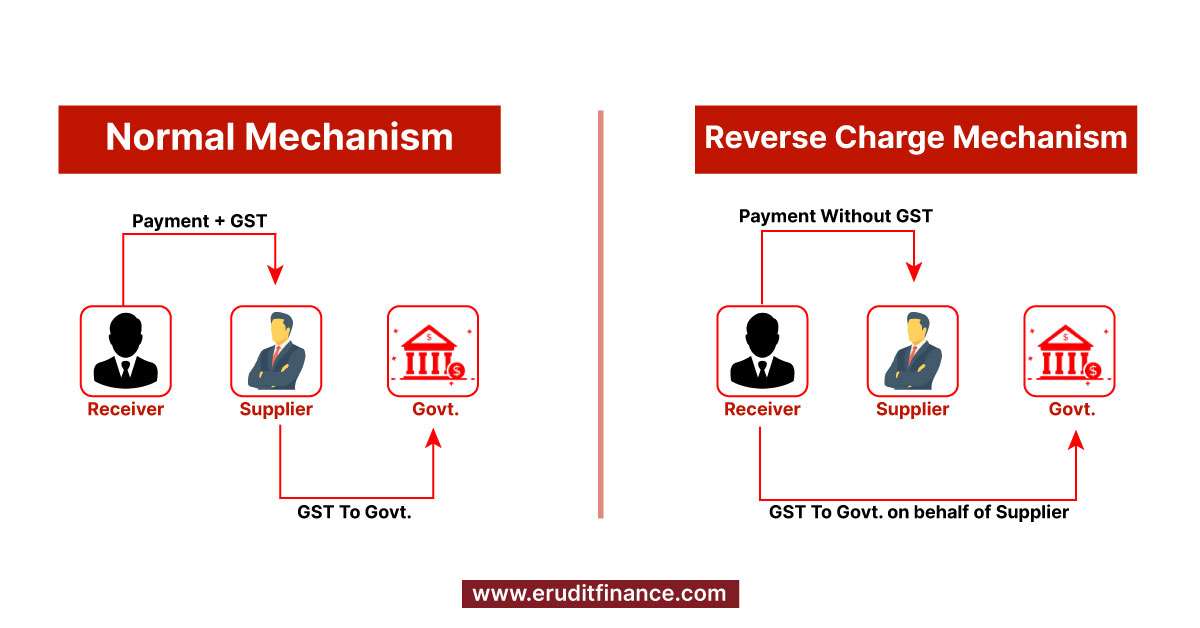In the realm of Goods and Services Tax (GST), the concept of “reverse charge GST” is a mechanism designed to shift the responsibility of tax payment from the supplier to the recipient of the goods or services. This mechanism has been put in place to ensure smooth tax compliance and enhance tax collection efficiency.
Under normal circumstances, the supplier of goods or services is liable to pay GST to the government. However, under the reverse charge mechanism, the liability shifts to the recipient. This typically happens in specific scenarios outlined by the tax authorities.
What Is Reverse Charge Mechanism?
The Reverse Charge Mechanism (RCM) is a unique provision in the Goods and Services Tax (GST) system where the liability to pay tax is shifted from the supplier to the recipient of the goods or services. In other words, under RCM, it is the buyer or the receiver of the goods/services who is liable to pay the tax instead of the supplier.
How Does Reverse Charge Work?
In the standard scenario of GST, the supplier collects the tax from the recipient and deposits it with the government. However, under the RCM, this responsibility is reversed. Here’s how it typically works

- Supplier-Side- When a registered supplier sells goods or services to a registered buyer, the supplier issues an invoice with GST included.
- Recipient-Side- In a scenario where RCM is applicable, the recipient of these goods/services is responsible for paying the GST directly to the government, instead of the supplier.
When is Reverse Charge Applicable?
RCM is generally applicable under specific conditions, which may vary across jurisdictions. However, common situations where RCM is often applied include
- Specific Goods/Services- Tax authorities identify certain goods or services for which RCM applies. This could include items like legal services, manpower supply, goods transported by road, etc.
- Unregistered Suppliers- If a registered business procures goods or services from an unregistered supplier, the recipient becomes liable to pay GST under RCM.
- E-commerce Transactions- In some cases, for services provided through e-commerce platforms, the operator becomes liable to pay GST under RCM on behalf of the supplier.
What Is the Limit of Reverse Charge?
There are two main limits to consider with Reverse Charge Mechanism (RCM) under GST
- Threshold Limit: A registered taxpayer isn’t liable for RCM if the total value of supplies received from unregistered suppliers in a single day is less than Rs. 5,000.
- Compulsory Registration: Unlike the regular GST registration threshold of Rs. 20 lakh (or Rs. 10 lakh in special cases), anyone paying tax under RCM must be registered under GST irrespective of their turnover. This means even small businesses that wouldn’t normally need GST registration are required to do so if they fall under RCM.
What Is the Difference Between Forward Charge and Reverse Charge?
The key difference between Forward Charge Mechanism (FCM) and Reverse Charge Mechanism (RCM) in GST lies in who is responsible for collecting and paying the tax.
| Feature | Forward Charge (FCM) | Reverse Charge (RCM) |
| Who collects GST | Supplier | Recipient |
| Seller registration | Not mandatory for all supplies | Mandatory for RCM supplies |
| Buyer registration | Mandatory | Mandatory |
| Threshold limit | Rs. 20 lakh (or Rs. 10 lakh in special cases) | Rs. 5,000 per day from unregistered suppliers |
What Is the Benefit of RCM in GST?
The Reverse Charge Mechanism (RCM) in Goods and Services Tax (GST) has several benefits for both the government and businesses. It is designed to enhance tax compliance, broaden the tax base, and ensure equitable distribution of tax liabilities. Here are some key benefits of RCM in GST
- Enhanced Tax Compliance
- Widening of Tax Base
- Efficient Tax Collection
- Level Playing Field
- Reduction in Tax Evasion
- Input Tax Credit (ITC) Benefit
- Simplicity in Compliance
- Better Monitoring of Transactions
Reverse Charge GST (FAQ)
What Is the GST Rate Under RCM?
The GST rate under RCM (Reverse Charge Mechanism) depends on the specific good or service being supplied. However, the most common rate applied under RCM is 18% (split as 9% SGST and 9% CGST).
How does Input Tax Credit (ITC) work under Reverse Charge?
Recipients paying tax under RCM can claim Input Tax Credit (ITC) for the tax paid. This allows businesses to offset the tax they have paid on inputs against the tax liability on their outputs, reducing the overall tax burden.
What are the GST rates under Reverse Charge Mechanism (RCM)?
The GST rates under RCM are the same as those under the regular mechanism. They vary based on the nature of goods or services and are categorized into different slabs like 5%, 12%, 18%, and 28%.
Is Reverse Charge applicable for both goods and services?
Yes, RCM is applicable for both goods and services. The specific goods/services and scenarios where RCM applies are notified by the tax authorities.
Where can businesses find more information about Reverse Charge in GST?
Businesses can refer to official GST guidelines, notifications, and circulars issued by the tax authorities. They can also consult with tax professionals or visit the official GST portal for updates and clarifications.
What Happens if RCM Is Not Paid?
Here are some common outcomes
- Interest Payment
- Penalties
- Legal Actions
- Blocking of Input Tax Credit (ITC)
- Audit and Scrutiny
- Blacklisting
Bottomline:-
RCM shifts tax payment responsibility to recipients in specific scenarios. It enhances tax compliance, widens the tax base, and offers ITC benefits. Businesses must maintain records, pay GST on time, and consult professionals. Non-compliance leads to penalties. Understanding RCM is crucial for effective tax management and regulatory adherence.
Also Read:










